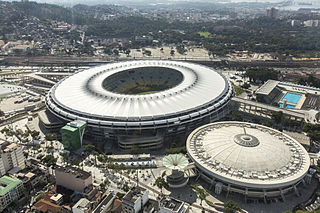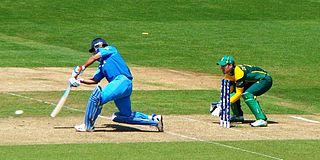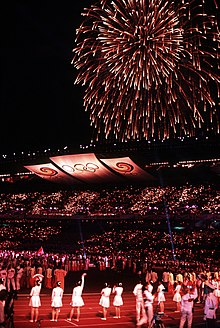
Sports in Japan are a significant part of Japanese culture. Both traditional sports such as sumo and martial arts, and Western imports like baseball, association football, basketball and tennis are popular with both participants and spectators.

Football is among the most popular sports in Japan, together with baseball, tennis, golf, sumo, and combat sports. Its nationwide organization, the Japan Football Association, administers the professional football leagues, including J.League, which is considered by many the most successful football league in Asia. Japan is also the country with the most comprehensively developed football in Asia in both men and women as well as in both futsal and beach soccer.

Sports in Brazil are those that are widely practiced and popular in the country, as well as others which originated there or have some cultural significance. Brazilians are heavily involved in sports. Football is the most popular sport in Brazil. Other than football, sports like volleyball, mixed martial arts, basketball, tennis, and motor sports, especially Formula One, enjoy high levels of popularity.

The most popular sport in Mexico currently is association football followed by boxing. However, there are regional variations: for example, baseball is the most popular sport in the northwest and the southeast of the country. Charrería is the national sport of Mexico. American rodeo is also popular in Mexico, but primarily in the northern half of the country. Basketball, American football and bull riding are also popular. Other sports followed by Mexicans are ice hockey, mixed martial arts, motorsports, taekwondo, and cycling. The tradition of bullfighting remains strong in Mexico.

Many sports in Iran are both traditional and modern. Tehran, for example, was the first city in West Asia to host the Asian Games in 1974, and continues to host and participate in major international sporting events to this day. Freestyle wrestling has been traditionally regarded as Iran's national sport, however today, football is the most popular sport in Iran. Because of economic sanctions, the annual government's budget for sport was about $80 million in 2010 or about $1 per person.

Sports in the Philippines is an important part of the country's culture. There are six major sports in the Philippines: basketball, boxing, tennis, football, billiards, and volleyball.
Sports in China consists of a variety of competitive sports. Traditional Chinese culture regards physical fitness as an important characteristic. China has its own national quadrennial multi-sport event similar to the Olympic Games called the National Games.
Sport in Pakistan is a significant part of Pakistani culture. Cricket is the most popular sport in Pakistan. Football has also gained popularity in recent years, and is the second most popular sport in the country. Field hockey is the national sport, and was popular for several decades, with some of Pakistan's greatest sporting accomplishments having taken place in this sport, along with squash. Polo and traditional sports like kabaddi and other well-known games are also played.

Sports in Indonesia are popular from both the participation and spectating aspect. Some popular sports in Indonesia are football, futsal, basketball, volleyball, badminton, and the native Indonesian martial art pencak silat. Badminton is arguably Indonesia's most successful sport. Indonesia has won gold medals in badminton in every Olympic Games since the sport was first introduced to the Olympics in 1992, with the exception of the 2012 Summer Olympics. Indonesia became the first grand winner in Badminton Olympics back then 1992. Indonesia regularly participates in the Thomas Cup, Uber Cup, and Sudirman Cup badminton championships, then became the first nation in history to complete those three titles. Indonesia also regularly participates in regional multi-events sport, such as the Southeast Asian Games, Asian Games, and Olympic Games. Indonesia is one of the major sport powerhouses in the Southeast Asian region, winning the Southeast Asian Games 10 times since 1977.
In Taiwan, some of the most popular sports include baseball, basketball, badminton, football, softball, table tennis, tennis, and volleyball. Martial arts such as tai chi and taekwondo are also practiced by many people. International-known athletes include Jeremy Lin, Tai Tzu-ying, Kuo Hsing-chun, Yu Chang, Chien-Ming Wang, Lin Yun-ju, Yang Chuan-kwang, Chou Tien-chen, Hsieh Su-wei, and Yani Tseng among others.

Basketball is the most popular sport overall in Asia. Cricket is the second most popular sport in Asia, and is most popular in South Asia. Other popular sports in Asia include association football, baseball, badminton and table tennis among others. There are also some traditional sports that are popular in certain regions of Asia, such as the South Asian sports kabaddi and kho-kho, and sepak takraw in Southeast Asia. Top sporting nations/regions in Asia include China, Japan, South Korea, Taiwan, India, Iran, Kazakhstan and Uzbekistan.

Because of Lebanon's unique geography, both summer and winter sports thrive in the country. In fact, during autumn and spring it is sometimes possible to engage in both activities on the same day; for example, skiing in the morning and swimming in the afternoon.

Association football is the most popular sport in almost all South American countries. There are a wide range of sports played in the continent of South America. Popular sports include rugby union, baseball, basketball, tennis, golf, volleyball, hockey, beach volleyball, motorsports and cricket. South America held its first Olympic Games in Rio de Janeiro, Brazil in 2016. Two years prior to this, major cities in Brazil hosted the 2014 FIFA World Cup.

India has a history of sports dating back to the Vedic period. Cricket is the most popular spectator sport; it generates the highest television viewership, with the Indian Premier League (IPL) being the most-followed league in the country. Football has also gained popularity, with the Indian Super League (ISL) being the highest level of domestic football, and the national team winning multiple gold medals at the Asian and South Asian Games. Additional football accomplishments include India having reached the Groupstage of the 1960 Olympics, qualified for the 1950 FIFA World Cup, and won the SAFF Championship. Other sports include kabaddi, badminton, tennis, and athletics, with kho-kho becoming the fourth-most viewed sport. India has also had success in field hockey, winning the World Cup and multiple medals in the Olympic Games. Sports such as golf, rugby, boxing, kickboxing, mixed martial arts, motorsport, wrestling, and basketball are featured throughout the country.
Sports in Ecuador influence the culture and its people. Football is the most popular sport, followed by volleyball, basketball, cycling and tennis.
Sports in Thailand play a significant role in Thai culture, with both participants and spectators engaging in a wide variety of activities. Muay Thai, a traditional martial art, is deeply ingrained in Thai history and has evolved into national sport. Aside from muay Thai, association football is the most popular sport in Thailand, followed by volleyball and badminton. There is also a diverse range of sports that are also popular throughout the country, including tennis, golf, swimming, athletics, cycling, motorsports, snooker, and sepak takraw, which is one of Thailand's two national sports along with muay Thai. Water sports such as scuba diving, kiteboarding, jet skiing, surfboarding, rafting, sea kayaking, windsurfing, wakeboarding, long boat racing, and long-tail boat racing are also popular among sports tourists and locals alike.

Sports in Somalia are regulated by the Ministry of Sports of Somalia. The government ministry works closely with the Somali Olympic Committee and various sports governing bodies, including the Somali Football Federation. Abdi Bile from Las Anod is Somalia's most decorated athlete in history; Abdi Bile also holds the highest number of Somali national records. The longest continuously serving national team captains of Somalia's two most popular sports, basketball and football, are Yusuf Qaafow and Hasan Babay respectively.

Kabaddi, is a contact sport, native to the Indian subcontinent. It is one of the most popular sports in India, played mainly among people in villages. India has taken part in four Asian Games in kabaddi, and won gold in all of them. Four forms of kabaddi played in India are Amar, Suranjeevi, huttuttoo, and Gaminee. Amar is generally played in Punjab, Haryana, the United States, Canada, and other parts of the world, mostly by Punjabi sportsmen. Suranjeevi is the most played form of kabaddi in India and the world. This is the form used in international matches generally and played in Asian Games. Huttuttoo was played by men in Maharashtra. In Gaminee style, seven players play on each side and a player put out has to remain out until all his team members are out. The team that is successful in outing all the players of the opponent's side secures a point. The game continues until five or seven such points are secured and has no fixed time duration.
Sport in Bangladesh is a popular form of entertainment as well as an essential part of Bangladeshi culture. Cricket is the most popular sport in Bangladesh followed by football. Ha-du-du is the national sport of Bangladesh.

India women's national kabaddi team represents India in international women's kabaddi competitions.



















